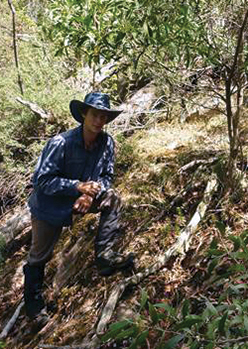
2012 Margaret Middleton Fund recipient Mr Ben Scheele, from the Fenner School of Environment and Society, Australian National University, used his award to research the decline of corroboree frogs in some sub-alpine regions of Australia.
Ben Scheele’s PhD research is based on understanding why some corroboree frog populations have survived despite the presence of the deadly fungal disease chytridiomycosis, while other populations have rapidly become extinct. The emergence of this wildlife disease has resulted in amphibian declines and extinctions globally. In sub-alpine regions of southern Australia chytridiomycosis is the major threatening process for the critically endangered corroboree frog.
Mr Scheele hypothesised that populations that co-occur with high numbers of the common eastern froglet are more likely to decline because this species carries the fungus without experiencing mortality, thus its presence would increase the frequency of disease in corroboree frogs. Funding awarded by the Academy from the Margaret Middleton Fund was used to finance the analysis of disease diagnostic samples collected from different populations of both species of frogs in the wild.
‘Without the support it would not have been possible to conduct this study because disease diagnostics are relatively expensive,’ he said.
‘I found that chytridiomycosis was most common in corroboree frog populations that co-occurred with large numbers of common eastern froglets. Where corroboree frog populations occurred by themselves disease was uncommon, providing a positive outlook for these populations. This knowledge is currently being used to inform the development of conservation strategies for the corroboree frog.’
© 2025 Australian Academy of Science